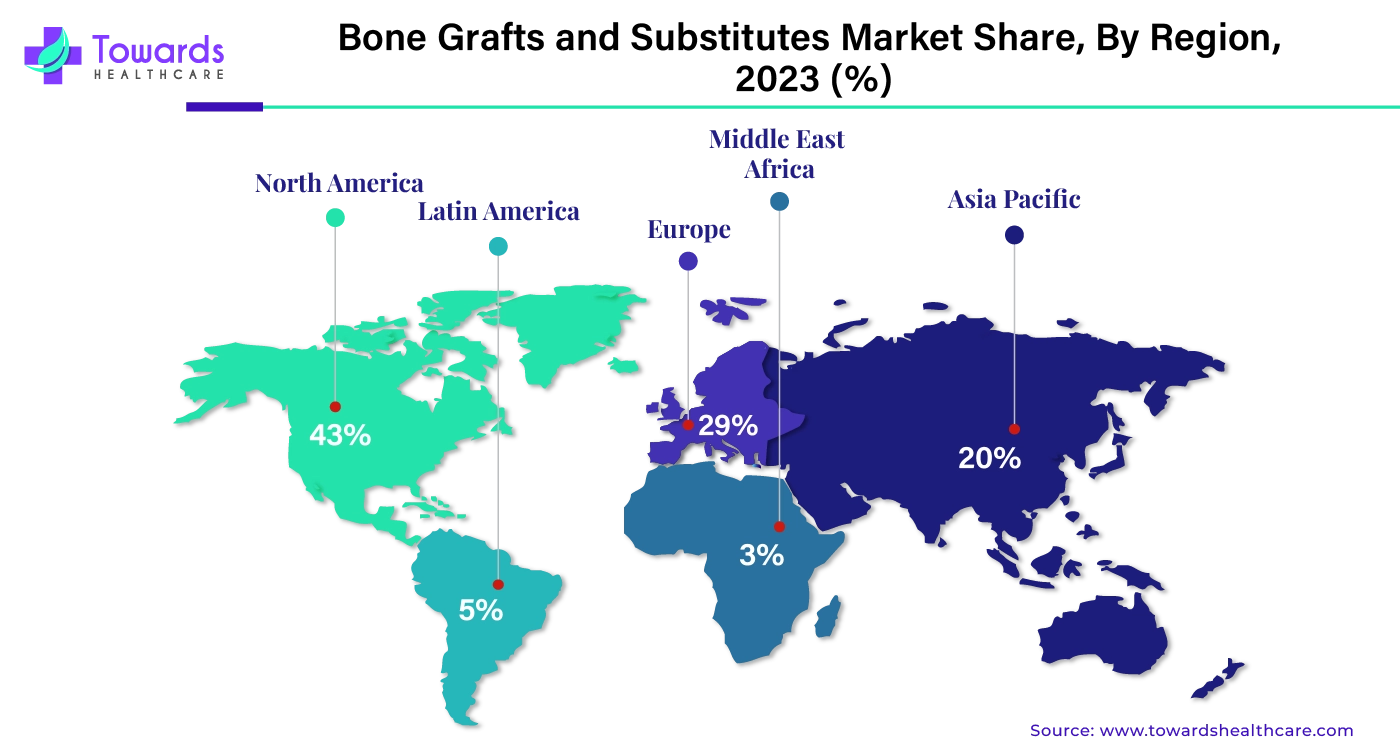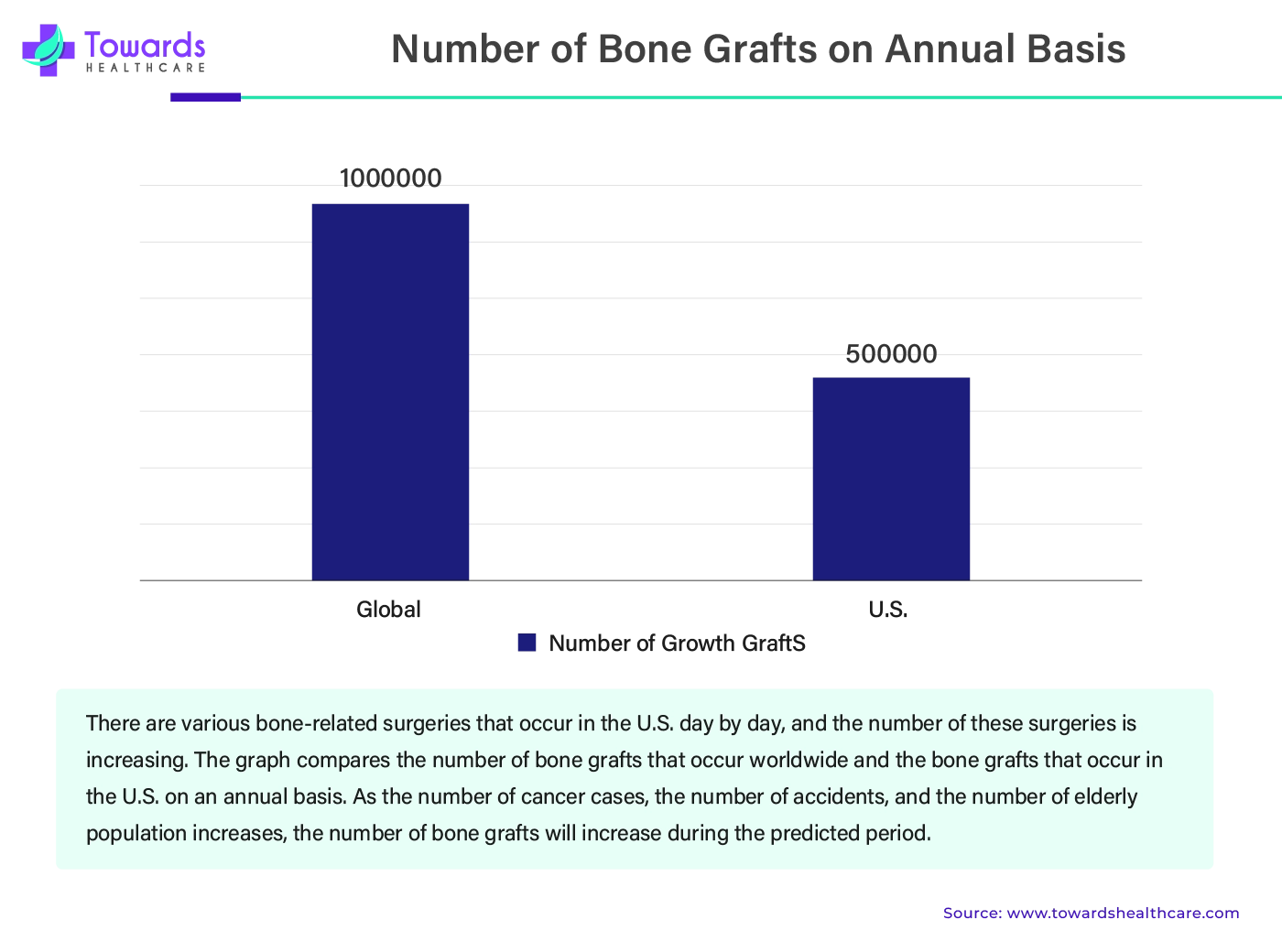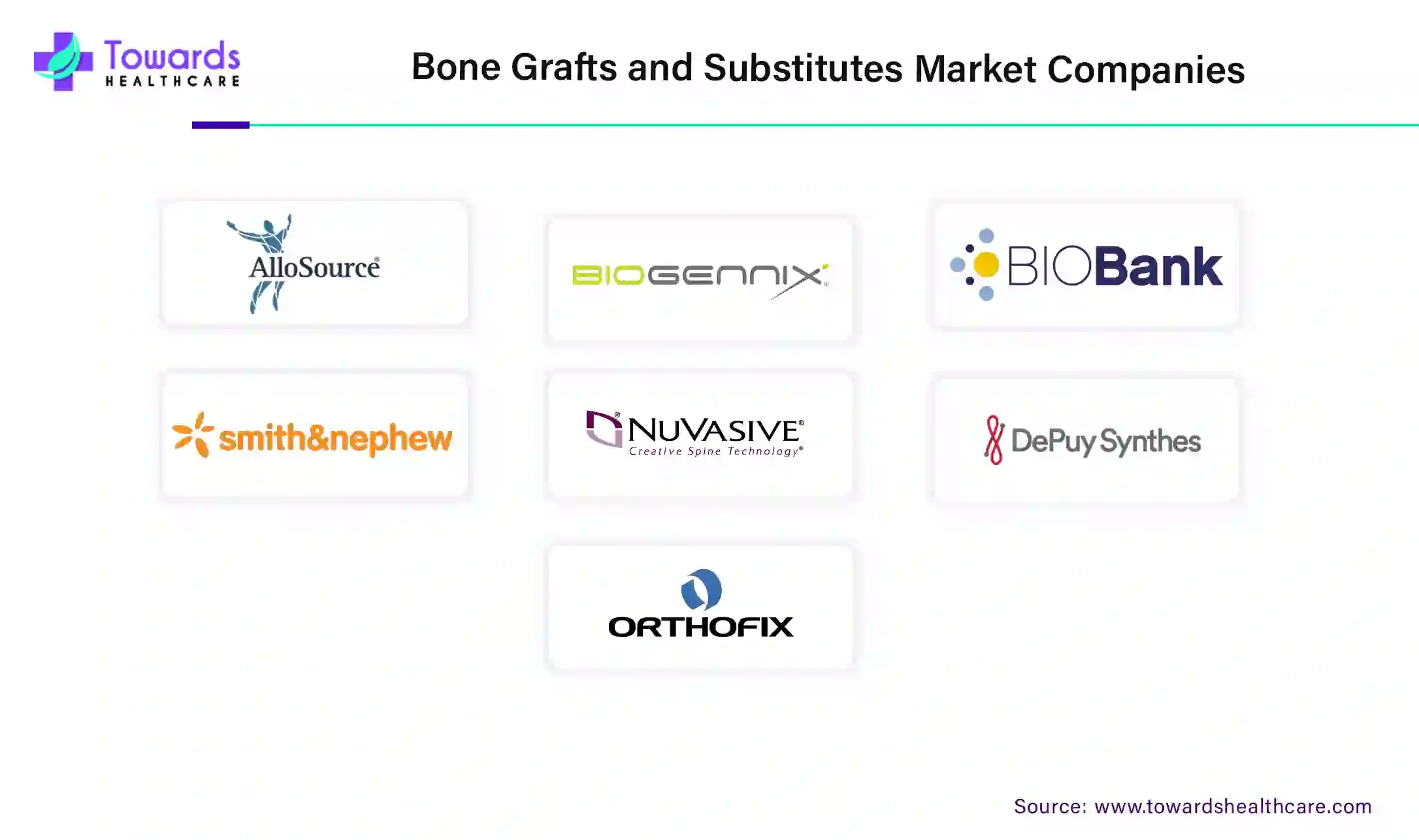December 2025

The global bone grafts and substitutes market size was estimated at US$ 2.99 billion in 2023 and is projected to grow to US$ 5.95 billion by 2034, rising at a compound annual growth rate (CAGR) of 6.45% from 2024 to 2034.

Bone grafts and bone substitutes are increasingly used in revision arthroplasty, fracture nonunion, traumatology, spine surgery, tumor surgery, and infection. The bone grafts and substitutes market provides bone grafts and bone substitutes for all these procedures in order to stabilize fixation and restoration of alignment for proper reconstruction of bones. After blood, bone is the most commonly transplanted tissue, which suggests that the demand for these grafts is high in the healthcare industry. As cases of bone cancer, bone infection, and spine injuries increase, the demand for bone substitutes and grafts is increasing. In the future, with evidence-based research, healthcare researchers and professionals will be able to develop high-quality grafts while ensuring the products are in an affordable range.
The above infographic showcases different AI models and how they are used in various steps involved in bone grafting. Each AI model has its unique ability, which helps develop high-quality bone grafts and bone substitutes in less time and with more accuracy.
Artificial Intelligence (AI) is significantly contributing to different segments of medical care, such as diagnostics, forecasting, patient monitoring, patient treatment, and so on. In the case of bone tissue engineering, AI plays a significant role in different steps. These steps include screening, modeling, optimization, parameter setting, synthesis, diagnostics, and developing solutions. Implementation of AI significantly reduces treatment and recovery time. As rigorous validation and testing are done in bone tissue engineering, a large amount of data is generated, and a lot of clinical trials are conducted, which leads to difficulty in manual analysis, and the chances of human errors are increased. AI becomes an essential tool in such cases, and the accuracy of overall results is improved.
For instance,
Bone fractures are very common during accidents and have become a public health issue. According to the World Health Organization, every year, there are around 1.3 million deaths, and around 20 to 50 million people are injured due to road accidents. Traffic accidents were in 9th place when it came to deaths, and it is estimated that it will rise to 5th number by the year 2030. This issue has promoted the growth of the bone grafts and substitutes market. During severe accidents, bones are crushed or heavily damaged, making it impossible for the body to heal and reconstruct the bone structure. In such cases, surgeons use new pieces of bone for proper healing.
One of the restraining factors for the market’s growth is the high cost of bone grafts and substitutes. There are several reasons why the grafts are expensive. One of the reasons is the materials used in the making of the grafts and substitutes. Some of the materials used are of high quality but are in low amounts. Another reason for the high cost is the process of making the grafts and substitutes. These products cannot be produced in bulk because different injuries and bone issues require different products, which are developed based on the screening and analysis of bone health. Due to the high cost, it is not possible for lower and middle-class people to afford these grafts. The high cost also restrains the growth of the market in developing and underdeveloped countries.
Bone grafting is one of the surgeries in which a lot of invasion occurs during analysis and bone grafting. It not only leads to long hospital stays and recovery time, but it can also lead to infections and infection-related shock syndrome. Hence, minimally invasive surgeries hold great potential for the growth of the bone grafts and substitutes market. As the name suggests, minimally invasive surgeries use minimal invasion or surgical opening compared to regular surgical openings. For instance, the S.M.A.R.T. Bone Grafting Technique is a novel, minimally invasive procedure that can be used in bone grafting methods. This technique can provide better bone regeneration outcomes along with fewer complications, less pain, and less swelling. It will also reduce hospital stays, which will reduce the overall cost of care and ultimately lead to better patient outcomes and patient satisfaction.
For instance,

By material, the allograft segment held the largest share of the bone grafts and substitutes market share by 57% in 2023. Allograft is dominantly used for bone grafting. In allograft, bone tissue from a donor is used for bone grafting. Allograft usage is heavily regulated throughout the process by the U.S. FDA. The advantages of using allograft are the availability in various sizes and shapes and no host structure sacrifice is needed. Allografts are usually harvested from the tibia, ribs, fibula, and femur.
For instance,
By material, the synthetic segment is expected to witness the fastest CAGR in the bone grafts and substitutes market during the predicted period of 2024-2034. Non-seous artificial materials are utilized as an alternative for bone grafts in synthetic bone grafts. Materials such as polymers, ceramics, metals, and composites are used to make synthetic bone graft material in a laboratory environment. Materials that closely imitate human bone architecture are the most effective for use in synthetic bone grafts. These biomaterials are frequently calcium-based, porous compounds like calcium phosphates. Synthetic grafts are superior to autografts and allografts in several ways, such as their infinite supply, ease of sterilizing, and ease of storage. In addition, synthetic grafts are very inexpensive, widely available, and free from concerns like viral transmission and donor site morbidity.
For instance,
By application, the spine fusion segment captured the largest bone grafts and substitutes market share in 2023. Spinal fusion is one of the most common operations for the neck or back. By 2060, it is anticipated that the number of posterior spinal fusions performed will have increased by 82% to 102%, with patients over 75 years old and women most likely to benefit from this increase in fusion rates. Up to 2040, gains in anterior and posterior cervical decompression and fusion were projected by different research to be 13.3% and 19.3%, respectively.
By application, the dental segment is estimated to exhibit the fastest growth in the bone grafts and substitutes market during the forecast period. A dental bone graft could be necessary if further procedures, including dental implants, are needed or if the surrounding teeth and gums are becoming unhealthy due to bone loss. Bone grafting is a common procedure used in dentistry for a number of purposes. Bone transplants are frequently required for clinical dental medical therapies such as periodontal surgery, sinus lift, ridge augmentation, dental implants, and socket preservation.
For instance,
By region, North America dominated the bone grafts and substitutes market share by 43% in 2023. North America’s market is significantly growing due to countries like the U.S. and Canada. The major factors that contribute to this growth are technological advances, the advanced healthcare system, and the growing awareness among citizens. The U.S. is the major contributor to the growth due to the growing number of spinal injuries among the older population and the growing use of bone grafting.

It is anticipated that by 2050, there will be 80 million people in the U.S. who are 65 years of age or older, up from 54 million in 2014. One With this rise. Correspondingly, the prevalence of degenerative spinal diseases has increased. Two In the upcoming years, there should be a rise in demand for spine surgery as a result of this. Many stakeholders, including patients, doctors, payers, and legislators, are becoming interested in the rising use of lumbar spinal fusion surgeries in the U.S.

By region, Asia Pacific is expected to grow at the fastest rate of 6.04% during the forecast period. The bone grafts and substitutes market is growing in Asia Pacific due to a large pool of patients, government investment, and growing healthcare infrastructure. The major countries that contribute to the growth of the market are India, China, South Korea, and Japan.
Most of the old population belongs to Asia Pacific. China, India, and Japan have the largest old-age population, and elderly people are more prone to bone injuries due to poor bone health. Spine fusion is the most common surgery done in elderly people, which indicates that more people in Japan will need bone grafting surgeries.
Europe is expected to grow at a considerable rate in the upcoming period. The rising prevalence of musculoskeletal disorders and the growing demand for minimally invasive surgeries augment market growth. The increasing healthcare expenditure and robust healthcare infrastructure contribute to market growth. Favorable government support and reimbursement policies drive the market. The rising incidence of post-menopausal women leads to osteoporosis, potentiating the chance of bone graft procedures. According to a recent European cross-sectional study on 11,452 women, 5,178 were postmenopausal women. Out of these, more than 4,000 postmenopausal women experienced menopausal symptoms.
In June 2024, Bone Biologics conducted the pilot clinical trials on the first two patients of the NB1 bone graft device developed for spine fusion in patients with degenerative disc disease (DDD). Jeffrey Frelick, President and CEO of Bone Biologics, commented that the company is delighted to treat the first two patients. He also added that the preclinical study results were promising, with a strong safety profile, fusion success, and bone healing of NB1, and they are optimistic about the success of NB1 in humans as well.

| Company Name | Biogennix |
| Headquarters | Irvine, California, U.S., North America |
| Recent Development | In June 2024, extensive scientific research describing the advanced features of Biogennix's TrelCor bone graft material was published. Biogennix is an osteobiologics firm that specializes in materials for bone transplant surgeries. TrelCor is a novel dual-phase bone transplant with a surface made of nanocrystalline hydroxycarbanoapatite (HCA) that has been specifically designed to promote bone growth. |
| Company Name | Paradigm BioDevices, Inc. |
| Headquarters | Massachusetts, U.S., North America |
| Recent Development | In July 2024, VisiCORE, a revolutionary bone graft harvesting device featuring a transparent collecting tube and exclusive Graft Retention Technology (GRT)TM, is being introduced by Paradigm BioDevices, Inc. for foot and ankle fusion procedures. In addition to minimizing bone graft loss during collection, lowering the number of passes necessary to extract an acceptable amount of bone graft, and reducing donor site flaws, the system allows users to view bone graft harvests in real time. |
By Material
By Application
By Region
December 2025
December 2025
November 2025
November 2025